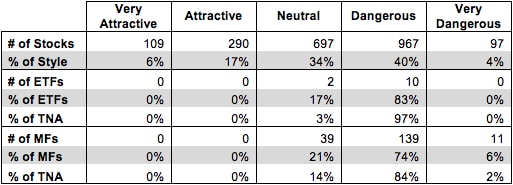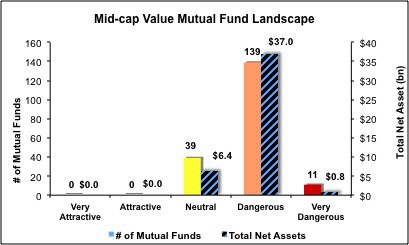The Mid-cap Value style ranks ninth out of the twelve fund styles as detailed in my Style Rankings for ETFs and Mutual Funds report. It gets my Dangerous rating, which is based on aggregation of ratings of 12 ETFs and 189 mutual funds in the Mid-cap Value style as of May 3, 2013. Prior reports on the best & worst ETFs and mutual funds in every sector and style are here.
Figures 1 and 2 show the five best and worst-rated ETFs and mutual funds in the style. Not all Mid-cap Value style ETFs and mutual funds are created the same. The number of holdings varies widely (from 25 to 2880), which creates drastically different investment implications and ratings. The best ETFs and mutual funds allocate more value to Attractive-or-better-rated stocks than the worst, which allocate too much value to Neutral-or-worse-rated stocks.
To identify the best and avoid the worst ETFs and mutual funds within the Mid-cap Value style, investors need a predictive rating based on (1) stocks ratings of the holdings and (2) the all-in expenses of each ETF and mutual fund. Investors need not rely on backward-looking ratings.
My fund rating methodology is detailed here.
Investors should not buy any Mid-cap Value ETFs or mutual funds because none get an Attractive-or-better rating. If you must have exposure to this style, you should buy a basket of Attractive-or-better rated stocks and avoid paying undeserved fund fees. Active management has a long history of not paying off.
Get my ratings on all ETFs and mutual funds in this style on my free mutual fund and ETF screener.
Figure 1: ETFs with the Best & Worst Ratings – Top 5
 * Best ETFs exclude ETFs with TNAs less than $100 million for inadequate liquidity.
* Best ETFs exclude ETFs with TNAs less than $100 million for inadequate liquidity.
Sources: New Constructs, LLC and company filings
Vanguard S&P Mid-Cap 400 Value ETF (IVOV) and SPDR S&P 400 Mid Cap Value ETF (MDYV) are excluded from Figure 1 because their total net assets (TNA) are below $100 million and do not meet our liquidity standards.
Figure 2: Mutual Funds with the Best & Worst Ratings – Top 5
 * Best mutual funds exclude funds with TNAs less than $100 million for inadequate liquidity.
* Best mutual funds exclude funds with TNAs less than $100 million for inadequate liquidity.
Sources: New Constructs, LLC and company filings
Seven funds are excluded from Figure 2 because their total net assets (TNA) are below $100 million and do not meet our liquidity standards.
iShares Morningstar Mid Value Index Fund (JKI) is my top-rated Mid-cap Value ETF and Victory Portfolios: Established Value Fund (VEVIX) is my top-rated Mid-cap Value mutual fund. Both earn my Neutral rating. For those investors who are priced out by VEVIX’s $2.5 million initial minimum, VEVYX offers the same holdings for only slightly higher costs.
Guggenheim S&P Midcap 400 Pure Value (RFV) is my worst-rated Mid-cap Value ETF and Munder Integrity Mid-cap Value Fund (MAIMX) is my worst-rated Mid-cap Value mutual fund. RFV earns my Dangerous rating and MAIMX earns my Very Dangerous rating.
Figure 3 shows that 399 out of the 2,160 stocks (over 23% of the market value) in Mid-cap Value ETFs and mutual funds get an Attractive-or-better rating. Given the amount of quality stocks available for ETF providers and mutual fund managers to choose from, there really should be some Attractive rated ETFs or mutual funds in the Mid-cap Value style.
The fact that no funds allocate enough value to Attractive-or-better rated stocks to earn an Attractive rating reflects poorly on both passive and active management.
The takeaways are: mutual fund managers allocate too much capital to low-quality stocks and Mid-cap Value ETFs hold poor quality stocks.
Figure 3: Mid-cap Value Style Landscape For ETFs, Mutual Funds & Stocks
 Sources: New Constructs, LLC and company filings
Sources: New Constructs, LLC and company filings
As detailed in “Cheap Funds Dupe Investors”, the fund industry offers many cheap funds but very few funds with high-quality stocks, or with what I call good portfolio management.
Investors need to tread carefully when considering Mid-cap Value ETFs and mutual funds, as 10 out of 12 ETFs (97% of total net assets) and 150 out of 189 mutual funds (86% of total net assets) in the Mid-cap Value style earn a Dangerous-or-worse rating. Investors in this style should focus on individual stocks instead.
Covidien plc (COV) is one of my favorite stocks held by Mid-cap Value ETFs and mutual funds and earns my Very Attractive rating. COV has grown after tax profit (NOPAT) by 14% compounded annually over the past five years. Consistent NOPAT growth helps COV to have an impressive return on invested capital (ROIC) of 13%. COV has been proactive in recent years growing its product lines as well as expanding its business into Asia and Latin America. The steady rise in COV’s ROIC attests to the success of this strategy. Despite its recent profit growth, COV is priced for permanent profit decline. At its current valuation of ~$64.23/share, COV has a price to economic book value ratio of 0.9, implying that COV’sNOPAT will permanently decline by 10%. Strong recent growth combined with low market expectations makes COV a stock poised for success.
EchoStar Corporation (SATS) is one of my least favorite stocks held by Mid-cap Value ETFs and mutual funds and earns my Very Dangerous rating. The outlook for SATS looks bleak. Its 2% ROIC is nowhere near high enough for the company to achieve economic profitability. SATS $2.8 billion in total debt is a concern as well given that its NOPAT was only $100 million last year and it had free cash flow of negative $300 million. Given its meager cash flows and significant debt, SATS currently has an economic book (zero growth) value of negative ~$4.07/share. However, SATS is currently valued at ~$39.29/share. To justify this high valuation, SATS would need to grow NOPAT by 16% compounded annually for 17 years. Low cash flow, significant debt, and a high valuation make SATS too risky for investors.
Figures 4 and 5 show the rating landscape of all Mid-cap Value ETFs and mutual funds.
My Style Rankings for ETFs and Mutual Funds report ranks all styles and highlights those that offer the best investments.
Figure 4: Separating the Best ETFs From the Worst Funds
Figure 5: Separating the Best Mutual Funds From the Worst Funds
Review my full list of ratings and rankings along with reports on all 12 ETFs and 189 mutual funds in the Mid-cap Value style.
Sam McBride contributed to this report.
Disclosure: David Trainer and Sam McBride receive no compensation to write about any specific stock, sector, style or theme.


